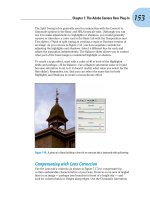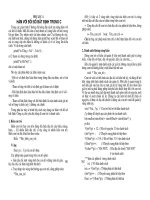Dive Into Python-Chapter 17. Dynamic functions
Bạn đang xem bản rút gọn của tài liệu. Xem và tải ngay bản đầy đủ của tài liệu tại đây (160.25 KB, 36 trang )
Chapter 17. Dynamic functions
17.1. Diving in
I want to talk about plural nouns. Also, functions that return other functions,
advanced regular expressions, and generators. Generators are new in Python
2.3. But first, let's talk about how to make plural nouns.
If you haven't read Chapter 7, Regular Expressions, now would be a good
time. This chapter assumes you understand the basics of regular expressions,
and quickly descends into more advanced uses.
English is a schizophrenic language that borrows from a lot of other
languages, and the rules for making singular nouns into plural nouns are
varied and complex. There are rules, and then there are exceptions to those
rules, and then there are exceptions to the exceptions.
If you grew up in an English-speaking country or learned English in a formal
school setting, you're probably familiar with the basic rules:
1. If a word ends in S, X, or Z, add ES. “Bass” becomes “basses”, “fax”
becomes “faxes”, and “waltz” becomes “waltzes”.
2. If a word ends in a noisy H, add ES; if it ends in a silent H, just add S.
What's a noisy H? One that gets combined with other letters to make a sound
that you can hear. So “coach” becomes “coaches” and “rash” becomes
“rashes”, because you can hear the CH and SH sounds when you say them.
But “cheetah” becomes “cheetahs”, because the H is silent.
3. If a word ends in Y that sounds like I, change the Y to IES; if the Y is
combined with a vowel to sound like something else, just add S. So
“vacancy” becomes “vacancies”, but “day” becomes “days”.
4. If all else fails, just add S and hope for the best.
(I know, there are a lot of exceptions. “Man” becomes “men” and “woman”
becomes “women”, but “human” becomes “humans”. “Mouse” becomes
“mice” and “louse” becomes “lice”, but “house” becomes “houses”. “Knife”
becomes “knives” and “wife” becomes “wives”, but “lowlife” becomes
“lowlifes”. And don't even get me started on words that are their own plural,
like “sheep”, “deer”, and “haiku”.)
Other languages are, of course, completely different.
Let's design a module that pluralizes nouns. Start with just English nouns,
and just these four rules, but keep in mind that you'll inevitably need to add
more rules, and you may eventually need to add more languages.
17.2. plural.py, stage 1
So you're looking at words, which at least in English are strings of
characters. And you have rules that say you need to find different
combinations of characters, and then do different things to them. This
sounds like a job for regular expressions.
Example 17.1. plural1.py
import re
def plural(noun):
if re.search('[sxz]$', noun): 1
return re.sub('$', 'es', noun) 2
elif re.search('[^aeioudgkprt]h$', noun):
return re.sub('$', 'es', noun)
elif re.search('[^aeiou]y$', noun):
return re.sub('y$', 'ies', noun)
else:
return noun + 's'
1 OK, this is a regular expression, but it uses a syntax you didn't see in
Chapter 7, Regular Expressions. The square brackets mean “match exactly
one of these characters”. So [sxz] means “s, or x, or z”, but only one of
them. The $ should be familiar; it matches the end of string. So you're
checking to see if noun ends with s, x, or z.
2 This re.sub function performs regular expression-based string
substitutions. Let's look at it in more detail.
Example 17.2. Introducing re.sub
>>> import re
>>> re.search('[abc]', 'Mark') 1
<_sre.SRE_Match object at 0x001C1FA8>
>>> re.sub('[abc]', 'o', 'Mark') 2
'Mork'
>>> re.sub('[abc]', 'o', 'rock') 3
'rook'
>>> re.sub('[abc]', 'o', 'caps') 4
'oops'
1 Does the string Mark contain a, b, or c? Yes, it contains a.
2 OK, now find a, b, or c, and replace it with o. Mark becomes Mork.
3 The same function turns rock into rook.
4 You might think this would turn caps into oaps, but it doesn't. re.sub
replaces all of the matches, not just the first one. So this regular expression
turns caps into oops, because both the c and the a get turned into o.
Example 17.3. Back to plural1.py
import re
def plural(noun):
if re.search('[sxz]$', noun):
return re.sub('$', 'es', noun) 1
elif re.search('[^aeioudgkprt]h$', noun): 2
return re.sub('$', 'es', noun) 3
elif re.search('[^aeiou]y$', noun):
return re.sub('y$', 'ies', noun)
else:
return noun + 's'
1 Back to the plural function. What are you doing? You're replacing the
end of string with es. In other words, adding es to the string. You could
accomplish the same thing with string concatenation, for example noun +
'es', but I'm using regular expressions for everything, for consistency, for
reasons that will become clear later in the chapter.
2 Look closely, this is another new variation. The ^ as the first character
inside the square brackets means something special: negation. [^abc] means
“any single character except a, b, or c”. So [^aeioudgkprt] means any
character except a, e, i, o, u, d, g, k, p, r, or t. Then that character needs to be
followed by h, followed by end of string. You're looking for words that end
in H where the H can be heard.
3 Same pattern here: match words that end in Y, where the character
before the Y is not a, e, i, o, or u. You're looking for words that end in Y that
sounds like I.
Example 17.4. More on negation regular expressions
>>> import re
>>> re.search('[^aeiou]y$', 'vacancy') 1
<_sre.SRE_Match object at 0x001C1FA8>
>>> re.search('[^aeiou]y$', 'boy') 2
>>>
>>> re.search('[^aeiou]y$', 'day')
>>>
>>> re.search('[^aeiou]y$', 'pita') 3
>>>
1 vacancy matches this regular expression, because it ends in cy, and c
is not a, e, i, o, or u.
2 boy does not match, because it ends in oy, and you specifically said
that the character before the y could not be o. day does not match, because it
ends in ay.
3 pita does not match, because it does not end in y.
Example 17.5. More on re.sub
>>> re.sub('y$', 'ies', 'vacancy') 1
'vacancies'
>>> re.sub('y$', 'ies', 'agency')
'agencies'
>>> re.sub('([^aeiou])y$', r'\1ies', 'vacancy') 2
'vacancies'
1 This regular expression turns vacancy into vacancies and agency into
agencies, which is what you wanted. Note that it would also turn boy into
boies, but that will never happen in the function because you did that
re.search first to find out whether you should do this re.sub.
2 Just in passing, I want to point out that it is possible to combine these
two regular expressions (one to find out if the rule applies, and another to
actually apply it) into a single regular expression. Here's what that would
look like. Most of it should look familiar: you're using a remembered group,
which you learned in Section 7.6, “Case study: Parsing Phone Numbers”, to
remember the character before the y. Then in the substitution string, you use
a new syntax, \1, which means “hey, that first group you remembered? put it
here”. In this case, you remember the c before the y, and then when you do
the substitution, you substitute c in place of c, and ies in place of y. (If you
have more than one remembered group, you can use \2 and \3 and so on.)
Regular expression substitutions are extremely powerful, and the \1 syntax
makes them even more powerful. But combining the entire operation into
one regular expression is also much harder to read, and it doesn't directly
map to the way you first described the pluralizing rules. You originally laid
out rules like “if the word ends in S, X, or Z, then add ES”. And if you look
at this function, you have two lines of code that say “if the word ends in S,
X, or Z, then add ES”. It doesn't get much more direct than that.
17.3. plural.py, stage 2
Now you're going to add a level of abstraction. You started by defining a list
of rules: if this, then do that, otherwise go to the next rule. Let's temporarily
complicate part of the program so you can simplify another part.
Example 17.6. plural2.py
import re
def match_sxz(noun):
return re.search('[sxz]$', noun)
def apply_sxz(noun):
return re.sub('$', 'es', noun)
def match_h(noun):
return re.search('[^aeioudgkprt]h$', noun)
def apply_h(noun):
return re.sub('$', 'es', noun)
def match_y(noun):
return re.search('[^aeiou]y$', noun)
def apply_y(noun):
return re.sub('y$', 'ies', noun)
def match_default(noun):
return 1
def apply_default(noun):
return noun + 's'
rules = ((match_sxz, apply_sxz),
(match_h, apply_h),
(match_y, apply_y),
(match_default, apply_default)
) 1
def plural(noun):
for matchesRule, applyRule in rules: 2
if matchesRule(noun): 3
return applyRule(noun) 4
1 This version looks more complicated (it's certainly longer), but it does
exactly the same thing: try to match four different rules, in order, and apply
the appropriate regular expression when a match is found. The difference is
that each individual match and apply rule is defined in its own function, and
the functions are then listed in this rules variable, which is a tuple of tuples.
2 Using a for loop, you can pull out the match and apply rules two at a
time (one match, one apply) from the rules tuple. On the first iteration of the
for loop, matchesRule will get match_sxz, and applyRule will get apply_sxz.
On the second iteration (assuming you get that far), matchesRule will be
assigned match_h, and applyRule will be assigned apply_h.
3 Remember that everything in Python is an object, including functions.
rules contains actual functions; not names of functions, but actual functions.
When they get assigned in the for loop, then matchesRule and applyRule are
actual functions that you can call. So on the first iteration of the for loop, this
is equivalent to calling matches_sxz(noun).
4 On the first iteration of the for loop, this is equivalent to calling
apply_sxz(noun), and so forth.
If this additional level of abstraction is confusing, try unrolling the function
to see the equivalence. This for loop is equivalent to the following:
Example 17.7. Unrolling the plural function
def plural(noun):
if match_sxz(noun):
return apply_sxz(noun)
if match_h(noun):
return apply_h(noun)
if match_y(noun):
return apply_y(noun)
if match_default(noun):
return apply_default(noun)
The benefit here is that that plural function is now simplified. It takes a list
of rules, defined elsewhere, and iterates through them in a generic fashion.
Get a match rule; does it match? Then call the apply rule. The rules could be
defined anywhere, in any way. The plural function doesn't care.
Now, was adding this level of abstraction worth it? Well, not yet. Let's
consider what it would take to add a new rule to the function. Well, in the
previous example, it would require adding an if statement to the plural
function. In this example, it would require adding two functions, match_foo
and apply_foo, and then updating the rules list to specify where in the order
the new match and apply functions should be called relative to the other
rules.
This is really just a stepping stone to the next section. Let's move on.
17.4. plural.py, stage 3
Defining separate named functions for each match and apply rule isn't really
necessary. You never call them directly; you define them in the rules list and
call them through there. Let's streamline the rules definition by anonymizing
those functions.
Example 17.8. plural3.py
import re
rules = \
(
(
lambda word: re.search('[sxz]$', word),









